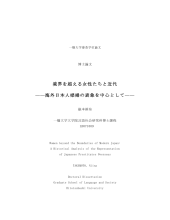177 0 0 0 OA 優生学と結びつく「からゆき」批判の検討
- 著者
- 嶽本 新奈
- 出版者
- ジェンダー史学会
- 雑誌
- ジェンダー史学 (ISSN:18804357)
- 巻号頁・発行日
- vol.5, pp.21-34, 2009 (Released:2010-11-02)
- 参考文献数
- 22
The opening of Japan in the mid 19th century encouraged Japanese women's emigration overseas.Because most of them engaged in prostitution abroad, the existence of these women, usually known as Karayuki, was the focal point of anti-prostitution criticisms in Japan from the early Meiji era. Moral advocates and anti-prostitution activists regarded their presence as a possible disgrace to the nation. However, their discursive circumstances changed in the Taisho era with the inflow and circulation of the ideas of eugenics, which were repeatedly featured in Kakusei, the official bulletin of Kakusei-kai, one of the most influential anti-prostitution organisations in Japan. In this paper I explore the way in which criticism of Karayuki by the anti-prostitution movement was incorporated into a narrative of eugenics, and how its discursive entity resulted in what can best be termed the alleged crisis of "blood purity" of the Japanese race in the Taisho era. The ideas of eugenics provided theoretical background and offered a highly effective remedy for the anti-prostitution movement as an antidote against both licensed prostitution in the body politic of Japan and "unlicensed" prostitution abroad. By evoking hygienic images, the narratives of eugenics diagnosed prostitution and prostitutes as social pathogen. That is, as the main source of "venereal diseases" threatening "domestic purity." This perspective of racial contamination shaped a crucial aspect of anti-Karayuki criticism, which had never before been in focus: Karayuki's ignorance of interracial intercourse as a representation of an encroachment on the nation's racial purity. The scientific guise of eugenics manipulatively transformed the ethical discourse of sex and the moral discourse of prostitution into the obscure but evocative discourses of "blood," "race," and "national purity." Karayuki's sexual economy began to be imagined as the dismal locus of racial contamination, which then provoked severe assaults on Karayuki.
2 0 0 0 IR 境界を超える女性たちと近代 : 海外日本人娼婦の表象を中心として
- 著者
- 嶽本 新奈 Takemoto Niina
- 出版者
- 一橋大学
- 巻号頁・発行日
- 2014
[4],107p
- 著者
- 嶽本 新奈
- 出版者
- The Gender History Association of Japan
- 雑誌
- ジェンダー史学 (ISSN:18804357)
- 巻号頁・発行日
- vol.7, pp.43-53, 2011
開国以降に海外へ出稼ぎに行った女性たちを「からゆき」と総称するが、「からゆき」の渡航に際してどのような人間が関わっていたのかを当時の九州メディアである『福岡日日新聞』、『門司新報』、『東洋日の出新聞』3紙を用い、主に「密航婦」検挙に関する記事から渡航幇助者を抽出したうえでジェンダーと役割を検討した。その結果、渡航幇助者の多面的なネットワークと、そこでの男女の役割の異同が明らかになったが、まず、渡航幇助の役割上では周旋業と国外就航船乗船までの宿泊場所提供に関しては男女の別なくどちらも役割を担っていた。一方、ジェンダー的役割に注目すると、「からゆきさんあがりの誘拐者」が自分の身をもって経済的に「成功」した実例とすることで渡航を促す役回りであったり、奉公口探しは主に同郷出身の同性に依頼するという縁故利用の習慣によって、女性という〈性〉が機能する役割があったことを確認できた。こうした属性は個々に独立したものではなく重なることもあり、女性たちが〈出稼ぎ〉目的の渡航をする際のネットワークの端緒にこのようなジェンダー的役割が組み込まれていたからこそ、数多くの女性たちが海を渡っていったといえる。<BR>このことは誘拐者とは男性であり加害者であり、「からゆき」とは女性であり被害者であるといった一面的な捉え方を排すが、同時に、女性がいかなる役回りで渡航幇助に関わっていたのかを見極める必要がある。女性もある種の加害性を帯びているのかに関しては、紙面の都合上、表象レベルにおいて新聞報道が男性幇助者と女性幇助者とでは異なり、とりわけ「からゆきさんあがりの誘拐者」は自身の過去を別の密航婦に引き継ぎしているに過ぎない受動的な主体として表象されており、その点で女性は女性の抑圧者になりきれていないことを指摘するに留めておく。
1 0 0 0 OA 優生学史研究はいかにして生権力論から免れ得るのか
- 著者
- 嶽本 新奈
- 出版者
- 日本科学史学会生物学史分科会
- 雑誌
- 生物学史研究 (ISSN:03869539)
- 巻号頁・発行日
- vol.95, pp.72-75, 2017-06-30 (Released:2019-06-03)
1 0 0 0 OA 「からゆき」渡航幇助者のジェンダーと役割の一考察 ─「密航婦」記事を手がかりにして─
- 著者
- 嶽本 新奈
- 出版者
- ジェンダー史学会
- 雑誌
- ジェンダー史学 (ISSN:18804357)
- 巻号頁・発行日
- vol.7, pp.43-53, 2011 (Released:2012-10-01)
- 参考文献数
- 9
開国以降に海外へ出稼ぎに行った女性たちを「からゆき」と総称するが、「からゆき」の渡航に際してどのような人間が関わっていたのかを当時の九州メディアである『福岡日日新聞』、『門司新報』、『東洋日の出新聞』3紙を用い、主に「密航婦」検挙に関する記事から渡航幇助者を抽出したうえでジェンダーと役割を検討した。その結果、渡航幇助者の多面的なネットワークと、そこでの男女の役割の異同が明らかになったが、まず、渡航幇助の役割上では周旋業と国外就航船乗船までの宿泊場所提供に関しては男女の別なくどちらも役割を担っていた。一方、ジェンダー的役割に注目すると、「からゆきさんあがりの誘拐者」が自分の身をもって経済的に「成功」した実例とすることで渡航を促す役回りであったり、奉公口探しは主に同郷出身の同性に依頼するという縁故利用の習慣によって、女性という〈性〉が機能する役割があったことを確認できた。こうした属性は個々に独立したものではなく重なることもあり、女性たちが〈出稼ぎ〉目的の渡航をする際のネットワークの端緒にこのようなジェンダー的役割が組み込まれていたからこそ、数多くの女性たちが海を渡っていったといえる。このことは誘拐者とは男性であり加害者であり、「からゆき」とは女性であり被害者であるといった一面的な捉え方を排すが、同時に、女性がいかなる役回りで渡航幇助に関わっていたのかを見極める必要がある。女性もある種の加害性を帯びているのかに関しては、紙面の都合上、表象レベルにおいて新聞報道が男性幇助者と女性幇助者とでは異なり、とりわけ「からゆきさんあがりの誘拐者」は自身の過去を別の密航婦に引き継ぎしているに過ぎない受動的な主体として表象されており、その点で女性は女性の抑圧者になりきれていないことを指摘するに留めておく。
- 著者
- 嶽本 新奈
- 出版者
- 教育科学研究会 ; 1951-
- 雑誌
- 教育 (ISSN:03869938)
- 巻号頁・発行日
- no.866, pp.73-80, 2018-03
1 0 0 0 IR 「からゆき」という歴史事象創出の背景--「性的自立性」の多様性
- 著者
- 嶽本 新奈
- 出版者
- 一橋大学大学院言語社会研究科
- 雑誌
- 言語社会
- 巻号頁・発行日
- no.2, pp.374-390, 2008-03
- 著者
- 嶽本 新奈
- 出版者
- 東京歴史科学研究会
- 雑誌
- 人民の歴史学 : 東京歴史科学研究会機関誌 (ISSN:03857875)
- 巻号頁・発行日
- no.209, pp.39-44, 2016-09
1 0 0 0 優生学史研究はいかにして生権力論から免れ得るのか
- 著者
- 嶽本 新奈
- 出版者
- 日本科学史学会生物学史分科会
- 雑誌
- 生物学史研究 (ISSN:03869539)
- 巻号頁・発行日
- vol.95, pp.72-75, 2017

